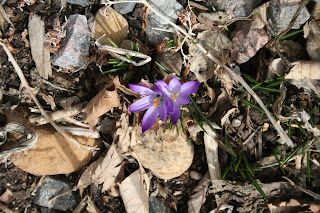Warm days in early March make us eager to get out and start gardening and with the days getting longer, it’s the perfect opportunity to get the garden ready for the season ahead. Start by gradually removing any vegetation and debris left from last season. It’s important to proceed slowly because as you’re cleaning up, you’ll discover many perennials and bulbs are starting show.
The remains of last year’s garden acts as a mulch, protecting early spring risers such as crocus, hyacinths, daffodils and tulips. Go gently around these bulbs and perennials, because it’s easy to damage them. You may want to switch from a leaf rake to a leaf blower or better yet simply clean up by hand. It’s important to leave some cover to protect these tender starts through the rest of the spring. Stay off those areas of the garden that are wet, in order to avoid compacting the garden soil any more than necessary.
As you're cleaning, you may find evidence of beneficial insect activity like this mantis egg sac. It's important to leave nest undisturbed so it has a chance to hatch naturally in the spring.
Now’s the time to evaluate the soil in your vegetable beds. Soil texture and richness are fundamental to your vegetable garden’s success and testing is something that should be done on a regular basis. Whether you’ve experienced specific problems, such as Tomato Blossom End Rot or you’ve been disappointed in your garden’s overall yields, it’s important to establish a baseline, in order to know how to proceed to improve your soil. You can do this yourself with a simple test kit or you can send a soil sample to the labs at Colorado State University. You’ll get a very comprehensive soil analysis from the labs at CSU. Once you’ve received your test results, bring the report in. We’ll help you choose the products you need in order to implement the changes they recommend.
Foundational to soil quality and heath is the practice of adding organic materials, called amendments. Effective soil amendments for the soils in our area include compost, peat moss and earthworm castings, but before you try digging in your garden make sure the ground is workable. Those areas exposed to the sun should be workable now. More shaded parts of the garden are still too wet to work. A simple way to do this is to grab a handful of soil and squeeze it. If it crumbles when you open your hand the soil is workable. If it stays in a clump, the soil is too wet, and you need to wait.
In your perennial gardens, now is the time to prune back ornamental grasses. They do best if you cut them down to five or six inches above the ground. Summer flowering shrubs such as Buddleia and Bluebeard should also be pruned now. Wait to prune spring blooming shrubs such as Lilac, Forsythia, Spirea until after they bloom. This is also the time to prune Group 3 Clematis. These varieties bloom on new wood in late June into August. They should be cut back to a living bud at about 24" from the ground in spring just as the buds begin to swell. If you don't prune, the flowers will tend to be only up at the top of the plant and the bare stems will be unattractive below. When to prune Clematis can be tricky depending on the bloom time and variety. If you’re not sure, don’t prune. If you’re uncertain about the blooming habits of the shrubs and vines in your landscape, don’t prune until you’ve had time to observe each plant’s growth and bloom cycle. Hold off pruning your roses until mid-April.
Watch for perennial weeds that may have wintered over. Groundsel, Mallow and others can survive the harshest winter weather, and many are blooming right now. Dig them up or treat with Burnout weed control. Starting your clean up now will mean a more productive gardening season.






No comments:
Post a Comment